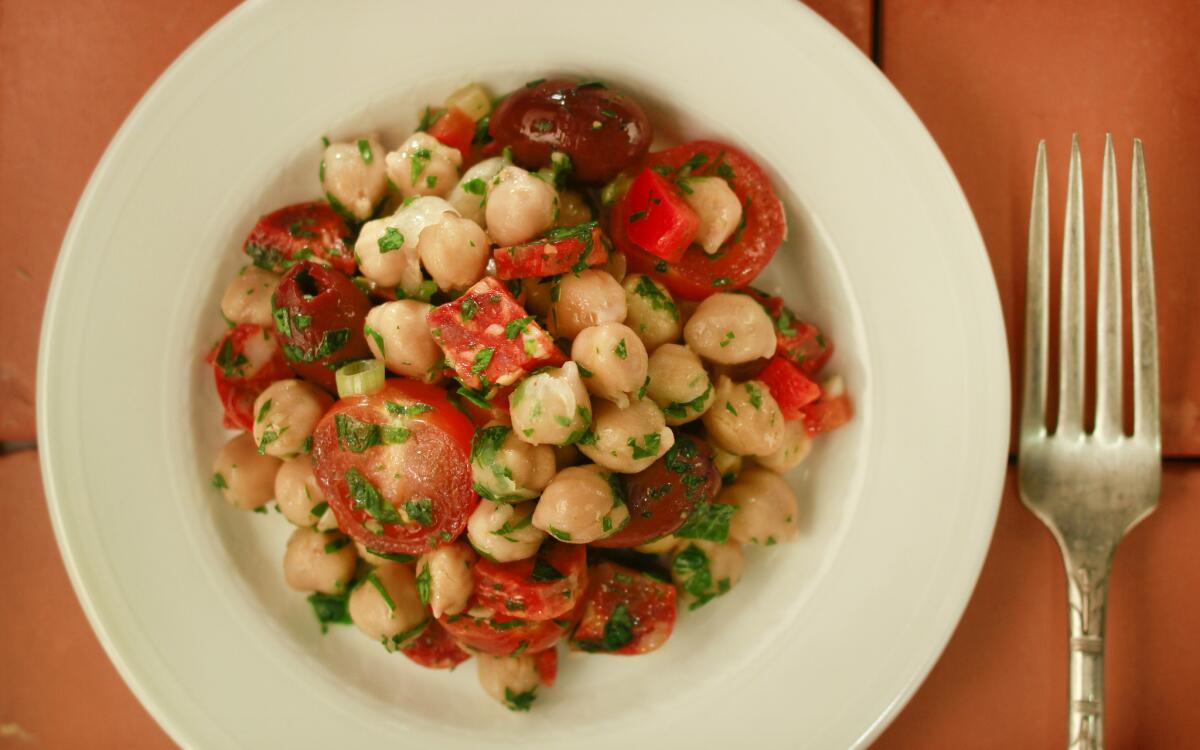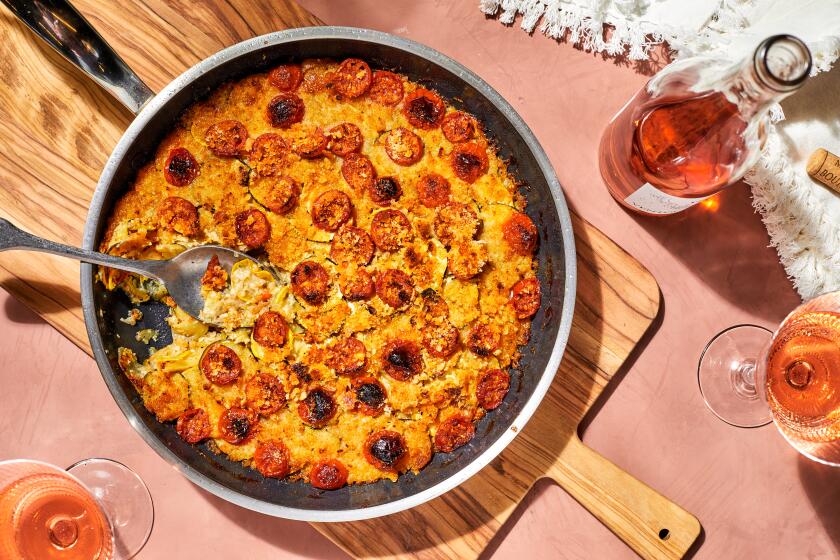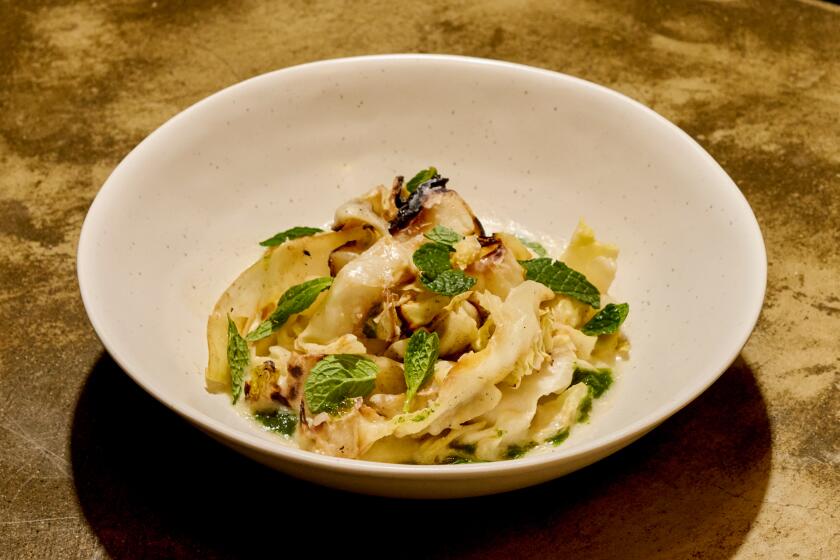Chickpea salad with chorizo (Garbanzos alinados con chorizo)

There’s an imaginary border that crosses through the South of France and northern Italy, angling through Greece and Turkey toward the Middle East. Call it the olive oil line -- to the north, the cuisines are flavored with butter and other oils; to the south, the warm Mediterranean flavors of olive oil predominate. Another culinary border follows it almost exactly: the Great Garbanzo Divide.
Also known as the chickpea, the garbanzo is a round, golden legume known in the Old World eons before true beans found their way from the New World. Garbanzos are popular in some parts of Italy and Greece as well as in North Africa, the Middle East and India.
But there are few places where they are more popular than in Spain, where garbanzos are everyday fare and cooks argue the merits of garbanzos coming from specific areas -- Segovia or Zamora, Badajoz or Cadiz. It’s where “my mother-in-law’s garbanzos” are compared with “your sister’s garbanzos.” Or, last Sunday’s garbanzos are compared with today’s garbanzos.
Garbanzos probably originated in Turkey. They were cultivated by the ancient Egyptians, transported throughout the Mediterranean by the Phoenicians. The Romans ate them and sent them packing with the legions.
Almost 90% of the world’s garbanzos are grown in India and Pakistan, where the Desi type, including a black variety, is prevalent.
In Spain and Latin America, the Kabuli type is most common. In Spain this includes three principal varieties -- the castellano, the pedrosillano and the blanco lechoso.
The most common is the castellano, now also widely grown in Mexico. It is rough-skinned, medium-sized (about the size of a hazelnut) and yellowish in color. A variation grown around Fuentesauco in Zamora province is especially esteemed because, cooked long and slow, it becomes creamy in texture without disintegrating. Fuentesauco garbanzos are special enough to have earned an Indicacion Geografica Protegida, a protected geographic origin, which means that they can be specifically labeled as coming from that area.
Garbanzos of the pedrosillano variety, also grown in the central region of Castilla y Leon, are tiny, fairly smooth, almost perfectly round and a dark caramel color. The blanco lechoso variety, grown in Andalusia, is pale, very large and irregularly shaped.
In Spain, garbanzos appear almost daily in the cocidos (one-pot meals) and potajes (thick soups) of every region. They have a special affinity for the strong flavors in Spanish cooking -- salt pork, sausages, tomatoes, cabbage, garlic and onions, pimenton and cumin.
The most emblematic Spanish meal including chickpeas is the grand cocido madrileno, Madrid-style meal-in-a-pot. Stewing hen, beef shin, hambone, pancetta, chorizo, morcilla sausage and chickpeas are slowly simmered with aromatic vegetables.
To serve, first the rich broth is strained off and cooked with noodles or rice to provide a first course. This is followed by platters of the chickpeas, cabbage and other vegetables as well as the meats and sausages. It’s a feast cooked in a single pot.
A less opulent version, puchero, is everyday fare in village homes. The frugal Spanish housewife will always cook more garbanzos than are needed for one meal, knowing she can incorporate them with leftover broth into a different soup the next day, such as sopa de picadillo. Leftover garbanzos, dressed with olive oil and vinegar, can also be reincarnated as a salad course.
Whereas cocido and puchero are served as two or three separate courses, potaje is a soup-stew with chickpeas, vegetables and small quantities of meat and sausage, served either as a first course for a main meal or else a sturdy main dish. One of the best of these is berza, from Andalusia.
Chickpeas are “slow food.” The dry legumes are soaked overnight (at least eight hours) in water, then simmered slowly until tender, about three hours. When properly cooked, chickpeas are tender but never mushy, with a delicious, nutty taste that no other dried legume has.
In Spain, where chickpeas are cooked on a daily basis, home cooks regularly use a pressure cooker to cut down on cooking time. In the pressure cooker, garbanzos cook in about 40 minutes -- and as long as they’re cooked with other flavorful ingredients, it’s hard to tell the difference.
Spanish cooks are particular about how garbanzos should be treated. They should be started in hot, not cold, water and then, after being brought to a rolling boil, the water should be reduced to a simmer. If you live someplace with especially hard water, cook them in filtered water or add a pinch of baking soda to the soaking and cooking water. Don’t salt garbanzos until they’ve cooked for an hour.
Little things to be sure, but no detail is too small south of the Great Garbanzo Divide.
Place the chickpeas in a medium bowl and toss with the salt, oil and lemon juice. Cover and set aside to marinate at least 2 hours, up to 24 hours.
Shortly before serving, add the parsley, garlic, chorizo, spring onion, bell pepper, tomatoes and olives. Add additional salt, if necessary. Serve cold or room temperature.
Get our Cooking newsletter.
Your roundup of inspiring recipes and kitchen tricks.
You may occasionally receive promotional content from the Los Angeles Times.













